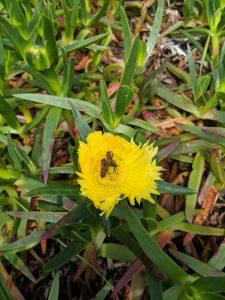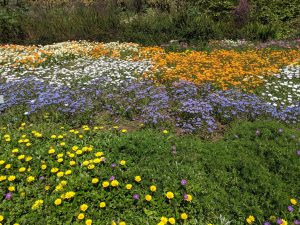World Bee Day 2019: Bee Basics for All

May 20 coincides with the birthday of Anton Janša, who is considered to be one of the fathers of modern beekeeping techniques. He was born on the 20th of May 1734 in Breznica, Slovenia. Having been born in a family of bee keepers, with his family owning more than hundred bee hives, Anton developed a keen interest in bees from a very young age. After observing bee activities for a very long time, Anton invented a new beehive design, perfected the techniques for the production of buckwheat honey, defined the role of drones, workers and queen, raised awareness of the importance of these pollinators, the threats they face , their contribution to sustainable development, and how to protect them.
He wrote several books on apiculture. His productive insights on bees were very much sought after, as a result, he travelled a lot in the Hapsburg Empire sharing his bee knowledge. His talents later caught the attention of Empress Maria Theresa who named him the official teacher of apiculture at the Habsburg court in Vienna. The importance of his work has gained new dimensions over time, and after his death in 1773, his books became the official textbooks of apiculture throughout the Hapsburg Empire. To honour his legacy and to raise awareness about the importance of bees and bee products, the Beekeepers Association of Slovenia with the support of the Republic of Slovenia, gave the initiative at the United Nations Organization to mark the birthday of Anton Janša, May 20, as World Bee Day. The first World Bee Day was commemorated in 2017. The aim of the UN is to raise awareness of the importance of pollinators, such as bees, the threats they face, their contribution to sustainable development, and how to protect them. Bees and other pollinators such as butterflies, bats and birds are a hidden treasure. Pollinators play an important role in food production, ensuring food security and they are also key to conserving biodiversity and a basis for the Sustainable Development Goals yet they continue to be under threat mainly from human activities.
For most people a bee is a black and gold insect that manufactures honey and occasionally delivers a painful sting to an unsuspecting victim. Yet this traditional image barely scratches the surface of the staggering varieties found in the bee world. The bee world comprises of up to twenty-five thousand (25 000) known species with many more to be discovered. Bee sizes range from the Perdita minina which is 2mm small to the Bombus dahlbomii (giant bumblebee) which is 40mm big. The living habits of bees also vary from species to species with some being either solitary such as the masons and leafcutter bees, meaning they live and raise their brood alone , or social bees such as the honey bees that live together in large colonies and help take care of the young and providing food and other services.
All bee families build nests in preparation for receipt of their young. Some bees build their nests underground, and are called mining or digging bees, while some prefer to nest in existing hollow stems made by beetles or other insects and are called hole nesters, while some create burrows or holes in dead wood, and are called carpenter bees. Some bees are generalists in foraging, they use pollen from a variety of plants, while others are specialists which only uses pollen from only one or to families of flowering plants. Foraging times also differ, with some preferring to forage at dawn or dusk, during daytime and others at night.
Regardless of colour, size and living habits, bees pollinate a huge range of plants vital to both humans, animals and the ecosystem at large. The most talked about benefit of bees is honey yet it is only produced by a handful of bee species. Even among honey bees, honey is much less valuable than the pollination services they provide. Besides the honey bees, other bees have been pollinating the continent’s flowering plants for centuries. Even in today’s vastly ever-changing and degraded environments, those bees continue to do their lion’s share of pollination especially for indigenous plants and wild flowers. Honey bee remarkable as it is doesn’t know how to pollinate tomatoes, does poorly compared to other bees at pollinating indigenous and food plants such as pumpkins, butternuts and indigenous trees.
The African Honey Bee is popular for its honey making skills that include producing honey in large quantities and of high quality. For decades, the African Honey Bee has been exported to other continents that either never used to have honey bees or had few honey bees, in a bid to either start or to increase honey production. The introduction of the African Honey bee to other places has been seen as a curse by native bee keepers as it is known for destroying native colonies which are vital for pollination than the way much less valuable honey production services the African honey bees provides.
Apart from the significant role they play as pollinators, bees occupy a place in the ecosystem food webs. Their diverse nesting and living behaviour and wide distribution mean they are and important source of food to a variety of predators across the animal kingdom. Predators include beewolves, parasitoid wasps, bee-eaters’ birds and flower crab spiders.
It has often been said that honey bees are responsible for one out of every three bites of food we eat. Most crops grown for their fruits, such as kiwifruit, pawpaw, watermelons, strawberries, apples, oranges, grapefruit, coconuts, lime, cotton, sunflower, litchi, macadamia nuts, lemons, mangoes, cactus, passion fruit, plums, peaches, pomegranate, berries, grapes and tomatoes require pollination by insects. Without bees, vegetables such as potatoes, onion, beetroot, cabbage, bell peppers, coriander, marrow, carrots pumpkins, melons, okra, cauliflower, broccoli, cucumber, butternuts, and eggplant, will all disappear from our plates.
Bees are not only food producers; they also play a critical role in maintaining natural plant communities and ensuring production of seeds in most flowering plants. Plant seeds will ensure the regeneration of flowering plants, creating habitat for animals, fodder, prevent soil erosion, aid in infiltration and ground water recharge, regulate rainfall patterns, regulate temperatures and add fertility to our soils.
Besides their ecological duties, bees are important for honey production. Honey is important for its contribution to household nutrition, for medicinal purposes and it creates employment for the bee keeping industry. In addition to honey, other useful products such as bee wax and propolis are produced. Bee breeders, flower growers, hive manufacturers, manufactures of protective clothing, candle making industry, medicines industry and cosmetic industry all rely on bees for employment and income.
Bee communities in Zimbabwe, both wild and managed, have been declining over the past decades and this has been attributed mainly to anthropogenetic activities such deforestation. Forage scarcity such as none production of flowers, over use of pesticides in the agriculture sector, monoculture and climate change are some of the threats to bee population.
It quite evident that forage scarcity is caused by deforestation, veld fires and absence of well-defined and poorly implemented land use policies. Zimbabwe in the past decades has been losing more than three hundred thousand (300 000) ha of forests yearly. Nectar plants such as Musasa, Mutuwa, Muzhanje, Mubvee, Aloe, Mupfuti, Mutondo, Muzeze, Muchecheni and Mukute are lost to deforestation and veld fires yearly. It is fair to say currently in Zimbabwe, the major contributors to loss of forests are expansion of agriculture activities, tobacco curing, logging, firewood, charcoal production, dam construction, mining activities, urban and rural settlements expansion. Changes in land use have resulted in a patchy distribution of food and nesting resources for bees. Nesting resources include dead wood and uncontaminated and stable land.
Haphazard land reform programmes, in spite of claims constantly made by the Government of Zimbabwe, give rise to invasion of forests by locals, thereby resulting in the depletion of nectaring plants. Once forests areas are invaded, mismanagement of forests resources hikes because land invaders ignore the provisions of the Forest Act. The Forest Act 19:05, Part IV Section 41, subsection (1) prohibits the cutting, felling, injuring and removal of forests resources from forests. Subsection (2) states that any person who contravenes subsection (1) shall be guilty of an offence and liable to a fine not exceeding level eight or to imprisonment for a period not exceeding one year or to both such fine and such imprisonment. The Forest Act, over the years has continued to be overlooked by law enforcement agencies and the community at large.
In addition to the problems highlighted above, mixed cropping agriculture in Zimbabwe has been replaced with monoculture, for example, tobacco production. The replacement of the former rich landscape with single crops that are laden with pesticide has and continues to cause bee mortality. Bees die in large numbers after foraging on flowers loaded with agrochemicals. During spraying programs for the termination of tsetse flies and mosquitoes, chemicals find themselves in most flowering plants. Many people in agriculture are not aware that while foraging, the Female Worker Bees carry agrochemical poisoned pollen back to their hives killing or weakening the whole brood and young honeybees in the hive. Promotion of use of herbicides in Agriculture is on the rise as they are considered to be less toxic to the environment, but they are equally bad for the bee population. As much as herbicides are not directly toxic to bees, they destroy many flowering plants which should provide bees with nectar and pollen. The overuse of agrochemicals and herbicides has left other farmers in horticulture, who rely on bees for pollination, anxious about how they will continue to be able to pollinate their crops.
The bee mortality situation today is being worse by climate change, which is causing some flowers to bloom earlier or later than usual, leaving bees with fewer and unreliable food sources. Without bees, all wild trees and plants that rely on bee pollination for regeneration will disappear from this planet. This will result in animals that eat plants that rely on bee pollination to be extinct. Carnivorous animals that feed on herbivores will also disappear. Short of wildlife such as birds, lions, elephants, hyenas, zebras, wild dogs, giraffes and plants the Zimbabwean Tourism Industry which is dependent of wild life will be nonexistent. Without game viewing, game hunting and trophy hunting the Zimbabwean Tourism Industry will suffer. This is very important to note because a lot people only think about bees in relation to honey and human food and nutrition without giving a thought to the role played by bees in pollinating wild plants and flowers.
For some people, bees are simply an annoyance. They buzz around, crawl inside soda and juice cans, chase people down the street and sometimes even sting. If you’re unlucky enough to be allergic, bees can literally be a lethal threat. Yet, the simple fact is, if bees didn’t exist, neither would humans. Stakeholders need to come up with sustainable ways to preserve our bee species. The following ways can be implemented if the bee population is to be protected and reserved.
More research work must be done to come up with bee friendly agrochemicals so as to provide bees with habitats free of pesticides.
Create habitat full of nectar and pollen resources and ample potential nesting resources. This can be achieved by planting a bee-friendly or a pollinator garden. Such a garden will not only lead to healthy and vibrant plants, it will ensure that bees continue to play their critical role of pollination in our ecosystem.

For those in the suburbs who love their well-manicured and well weeded lawns and yards they need to be aware that while doing so they are disturbing the bees’ ecosystem. A lawn or yard full of nectar flowers is a great thing. It is the perfect habitat for bees. Wildflowers, many of which we classify as weeds, are some of the most important food sources for bees. Before they think of weeding, they need to give these nectars laden ‘weeds’ an opportunity to bloom first for the bees and then before it goes to seed, they can pull them out.
Bees need water for survival. Once bees start to come to the new pollinator garden of native plants, wildflowers and flowering herbs, provide bees with water in the garden. A bird bath with some stones inside will be ideal for them to crawl on.
For soil nesting bees, having bare spot or sand pile in the garden will be ideal for their nesting needs. In addition, place a bee hive in the garden for honey bees which prefer to nest in hives. Food gardens are known to have 50% nectar plants or plants that rely on bees for pollination. These include pumpkins, bastard spinach, butternuts, tomatoes, potatoes, cucumbers, beetroots, bell peppers and melons. Always have a food garden at home or at your workplace.
In Zimbabwe, the remaining forests ought to be protected through incentives such as carbon credits, effective policy implementation, enforcing laws and legislation and community based natural resources management. Land Reform Policies such as Urban development, agriculture expansion and forest policies should speak to each other. Implementation of any of the policies should consider the protection and preservation of bee forage.
Quality education on the importance of the bees and other pollinators, by for example Bee Keepers Association of Zimbabwe should be given to the general population in support of the UN World Bee Day and SDGs.
- Empowering Marange’s Youth: Celebrating Africa Environment Day at Holy Ghost High School - March 14, 2024
- Sowing Seeds of Hope: Rejuvenating Chiadzwa’s Environment Through Tree Planting” - March 11, 2024
- 5 Years On. Growing Green: Cultivating a Sustainable Future For Macheke’s Children - March 11, 2024




